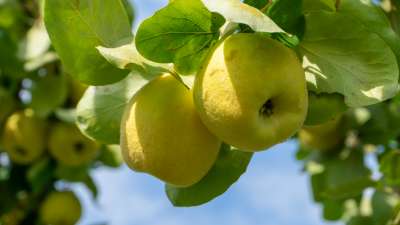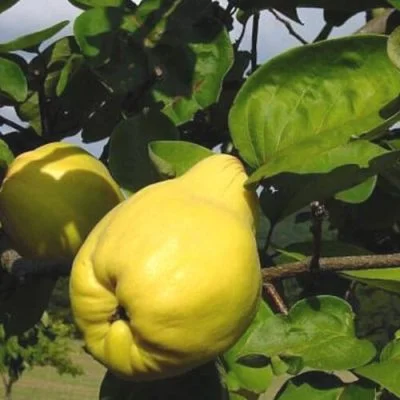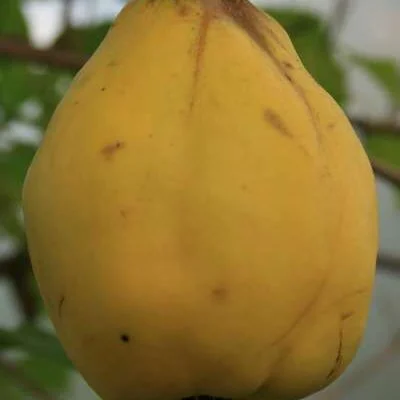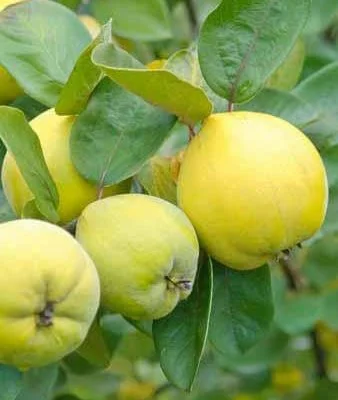Your basket is currently empty!
Tips & Recommendations for keeping your Quince Trees healthy
It is pleasing to see these very old heirloom quince trees beginning to increase in popularity as Quince trees are very pleasurable and a bit different to grow.
Buy from our quality range of Quince trees.
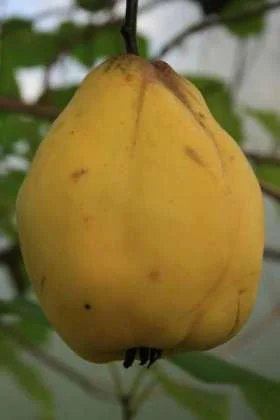
The Quince can easily double as an ornamental tree in the garden. The large, single pale pink flowers are nicely scented, have all the romantic appeal of a single wild rose, and open in May. They adorn, twiggy complex branches and are backed by softly downy oval leaves. The wood is quite dark and the foliage often gives ochre gold autumn leaf colour too.
A true Quince tree should not be confused with the shrubby ornamental Quince or Japonica [ Chaenomeles] although these twiggy low shrubs do bear edible fruits they are smaller, harder and less satisfactory. The flowers are nice and they are often used to adorn walls, blooming in early Spring. But if it’sspecifically the fruit you’re after then you need to make sure you are buying a proper Quince tree so it’s advisable to go to a fruit tree specialist to get what you want. The true Quince is actually closely related to the Pear, hence you get ‘Quince rootstocks’ on which Pears are grafted or budded.
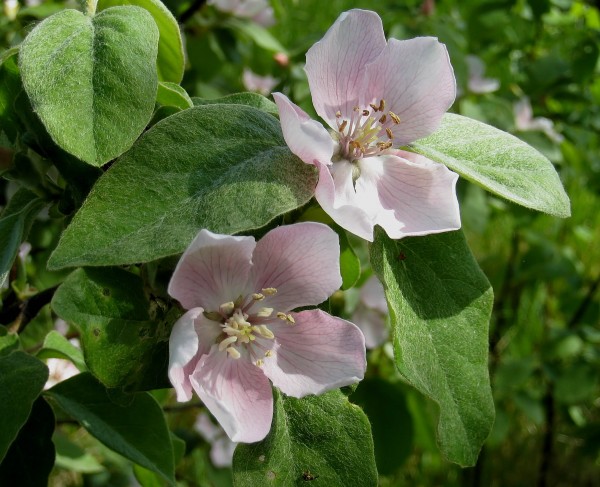
The Quince has in the past been mistakenly assumed of as half hardy but this is untrue. Although it’s fruits ripen better in southern latitudes this affects only the way in which the fruits are used, it does not mean you can’t grow Quince trees in this country and I have seen good specimens even in the North in perfectly ordinary situations.
In warmer countries the Quince ripens to a softer texture and is sweet enough to eat fresh. Maybe you can enjoy fully ripe Quinces and eat them for dessert if you afford the tree a hot sunny wall – or maybe you want to try growing one in a pot in the greenhouse – both are quite easily done. But in this country we are more used to using our Quinces for culinary purposes and to me this is no less pleasurable. The delights of Quince Marmalade and Quince jelly are not to be missed. Some cooks like to add a few slices of Quince to Apple pie because it imparts a delightful fragrant piquancy. The Quince fruit itself is very fragrant – pick a couple of fruits and bring them indoors and they will scent a room quite beautifully.
The word marmalade is actually derived from the Portugese name for Quince – marmo. Quince marmalade is very popular there.Trees usually begin to ripen only late in the Autumn and I would advise leaving them as long as possible so the flavour develops. Try to harvest in early November and they will then keep for a few weeks on a windowsill or place them in a cool garage. The tree should come into bearing in 2-3 years after planting; the lifespan of the tree is indefinite, often outlasting it’s owners.There are two distinct shapes when it comes to the fruit of the Quince. Some varieties are shaped like an apple and others have the outline of a Pear. Some varieties achieve quite weighty fruits and may actually make the branches droop when in full fruit, others are slightly more modest in proportion.
The good thing about Quinces are that all varieties are self fertile so you do not have to worry about compatibility and you don’t have to grow more than one tree unless you want to. Because the flowers open in May they do not get frosted very often and the set is usually good.
In growth the Quince is a fairly modestly growing tree and isn’t especially vigorous. Mature dimensions vary a lot according to the soil it is grown in but a height estimate between 8-14’ is normal and the spread is about the same. They can be controlled with sensible pruning if need be and are usually judged good trees for smaller gardens and of course are ideal incorporated into cottage gardens [bear in mind their great antiquity] and traditional orchards. The Quince adds a wonderful very distinct character and diversity.
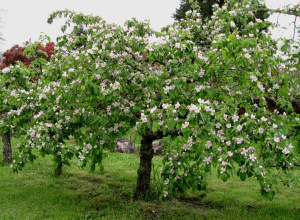
Soil conditions & spacing
The Quince is quite accommodating when it comes to soil and most types are suitable be it light and sandy to heartier types. Infact this is one of the very few fruit trees that can cope with a relatively poorly drained site. The trees will need a width of about 10’ in which to grow.
Soil preparation & planting
Standard soil preparation as for most fruit trees applies in that the area should be double dug, preferably some weeks beforehand and weeded thoroughly. The extra time between soil preparation and planting allows for the soil to break down further and also to deal with the secondary crop of weeds that will likely appear. An application of growmore at 4oz’s per square yard and lightly incorporated into the planting area.
Dig a hole wide and deep enough to comfortably take the roots. Drive the stake in first and place so that the stem of the tree is 2-3” away from it. Fill in with friable soil and firm well so that no air pockets remain between the roots and soil. The soil should by now be level with that of the surrounding area. A mulch can be applied of good organic material at a depth of 2” around the stem of the tree to prevent stress if the spring following is a dry one.
Pruning Quince trees
Usually consists of reducing strong upright leaders by about a third in late Summer. Badly placed branches or shoots can similarly be reduced, or removed completely. Aim to keep the lower trunk clear of branches so these should be removed at any early age, a trunk clearance of 3.5-4’ is usually about right for a Quince tree. The centre of the tree should be kept relatively open so if it is looking congested remove select branches completely at their base. There are no really hard and fast rules for pruning Quinces, it’s a matter of reducing some strong growths for fruiting purposes and aiming to achieve a pleasing shape. Quinces are seldom too formal in appearance and can have a charmingly off-kilter character.
Additional feeding
Is easily applied using Growmore or Bonemeal at a rate of 3oz’s per square yard. This will improve the quality of the crop and help avoid biennial bearing. It should be given in March of each year and raked lightly into the soil beneath the canopy of the tree.
Bugs & diseases
There aren’t many maladies that affect the Quince. In recent years the most troublesome has been leaf blight. This causes brown speckling on the leaves that intensifies as the season progresses and may lead to premature leaf drop. It is quite difficult to control; rake up and burn diseased and fallen leaves. Spray with Bordeaux mixture at 3 week intervals from the point when the leaves begin to unfurl until July.
The trees can also suffer from rust which displays itself pretty unmistakeably with bright orange patches that produce equally bright orange clouds of ‘dust’ Many plants and trees suffer from rust but each strain of rust is specific to that host so the rust on your Quince won’t spread to other plants or trees. It is controlled by the use of a copper based fungicide.
Other buds and creepy crawlies common to apple and pear do sometimes frequent Quinces and should be treated the same as described in the guide to growing apples. In general if holes appear in the leaves then a bug gun or provado should deal with the culprits.
Growing Quince trees in containers
It might seem initially surprising but I have had great success growing these trees in pots. Be fairly generous with the container size – a good half barrel is ideal, or not less than 24”. And a good loam based potting compost such as John Innes no 2 is ideal for them. I have had the most success with Siberian Gold as to variety, but most if not all cultivars should succeed. Quinces never seem to be in that much of a hurry to grow and accept the confines of a pot fairly readily. Situate it in a nice sheltered corner or on the patio with lots of sun and the tree should settle to fruit within a couple of seasons. I managed to keep one quite healthily for 8 years until it began to show signs of stress at which point I re planted it with fresh compost and did some judicious pruning and some root pruning as well; this was undertaken in Winter It rejuvenated spectacularly that Spring with lots of fresh new growth and the season after that had it’s best crop of fruit ever. It’s still going strong and is a pretty little tree of around 6’ in height and the flowers each spring are a joy. I have never given it any frost protection [here not far from the North Norfolk coast] and I feed it periodically with miracle grow. I would say it’s probably been the easiest fruit tree I have ever had to care for in a container. Customers report to me that Meech’s Prolific and also Vranja with it’s giant sized fruits have done well for them in containers too.
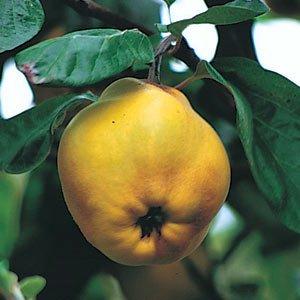
When to plant Quince trees
All year round is the short answer! The dormant season usually recommended by experts for planting fruit trees probably applies less to the Quince and as long as you can acquire on that’s in a pot then certainly they seem to transplant just as well during the later Spring and Summer and are then well established to weather the winter. Dormant season planting as a bare rooted tree along with all the other fruit and orchard trees remains a good time but I would probably avoid the very coldest months December to February although in favoured localities it should be ok. If in doubt you can always keep your tree in a bucket of constantly damp compost in a shed or cold greenhouse until you are ready to put the tree in.
Rootstocks for Quince trees
These trees are normally budded onto ‘Quince’ rootstocks, Quince A being the most commonly used and this rootstock produces a tree 10-12’ in height on average and imparts a certain amount of hardiness. Sometimes the trees are grown on their own roots as they can be pollarded or struck from root cuttings quite readily. Such trees will grow only a little larger than those on Quince A stock. They can also be propagated and grown on their own roots.
Thinning of fruit
Very occasionally the trees can get into a biennial cropping cycle and if this happens it will be beneficial to thin them out by about 50%, and this should be done when the fruits are about the size of a walnut. The tree should then return to cropping regularly every year rather than ‘boom or bust’.
Varieties of Quince
The range of varieties has grown in the last few years as interest in these bygone fruit trees is rekindled, but remains fairly small.
The most popular is the old standard ‘Meechs Prolific Quince Tree’ which is a tallish sometimes somewhat sparse tree but prolific with apple shaped fruits.
‘Quince Vranja’ which is pronounced Vranya has very impressive large and weighty divinely perfumed golden yellow downy fruits and is my pick of the best. It also has noticeably larger leaves.
Siberian Gold appears to be slightly more compact and has beautifully coloured fruits – and golden Autumn leaves too!
And a newer one that has come over from the continent is Rea’s Mammoth Quince Tree It seems quite similar to Vranja with rather larger fruits, maybe even a touch larger than that established variety.
Other varieties you may come across are L’escovatza from Northern Europe and ‘Portugal’.
You will find the best range of varieties of Quince from specialist fruit tree nurseries. Local stockists or garden centres may stock one variety at best, or none at all as demand is fairly subdued. If you buy from the Nursery that grows them and who has a good knowledge of fruit trees they can advise you on the rootstock used for the Quince trees and which one might be best for your locality as well as being able to give aftercare and planting advise.



